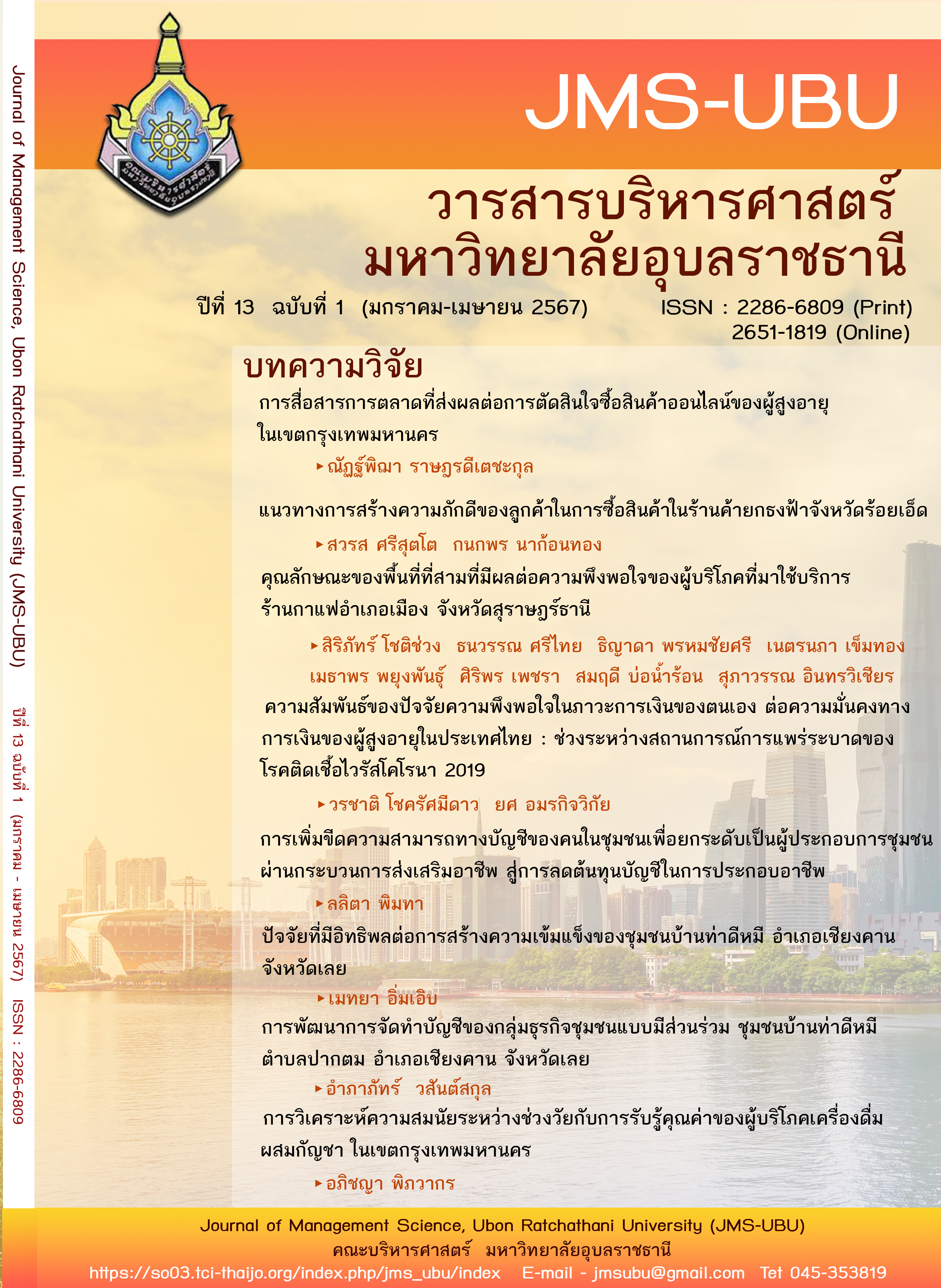การวิเคราะห์ความสมนัยระหว่างช่วงวัยกับการรับรู้คุณค่าของผู้บริโภคเครื่องดื่ม ผสมกัญชา ในเขตกรุงเทพมหานคร
Main Article Content
บทคัดย่อ
บทความนี้มีวัตถุประสงค์ เพื่อศึกษาความสมนัยของช่วงวัยกับการรับรู้คุณค่าของผู้บริโภคเครื่องดื่มผสมกัญชา ในเขตกรุงเทพมหานคร จากจำนวนประชากรในกรุงเทพมหานครที่มีอยู่จำนวนมากและเข้าถึงผลิตภัณฑ์เครื่องดื่มผสมกัญชาได้หลากหลายมุมมอง การรับรู้คุณค่าของผู้บริโภคต่อผลิตภัณฑ์เครื่องดื่มเป็นสิ่งสำคัญทางด้านธุรกิจ โดยใช้แบบสอบถามในการเก็บรวบรวมข้อมูล กลุ่มตัวอย่างคือ ประชากรที่มีอายุระหว่าง 21-76 ปี ในเขตกรุงเทพมหานคร ผู้บริโภคที่เคยซื้อเครื่องดื่มผสมกัญชาในประเทศไทย วิธีการสุ่มตัวอย่างแบบโควตา (Quota Sampling Design) โดยแบ่งกลุ่มตัวอย่างเป็น 4 กลุ่ม ได้แก่ 1) ช่วงวัยเบบี้บูมส์ (Generation Baby boomers) 2) ช่วงวัยเจเนอเรชั่นเอกซ์ (Generation X) 3) ช่วงวัยเจเนอเรชั่นวาย (Generation Y) 4) และช่วงวัยเจเนอเรชั่นซี (Generation Z) เก็บข้อมูลจากกลุ่มตัวอย่างกลุ่มละ 100 คน สถิติที่ใช้ในการวิเคราะห์ คือ ไคสแควร์ โดยผู้วิจัยใช้โปรแกรมสำเร็จรูป SPSS เพื่อการวิเคราะห์การสมนัย
ผลการวิจัย ช่วงวัยของผู้บริโภคมีผลต่อความสัมพันธ์กับการรับรู้คุณค่าต่อเครื่องดื่มผสมกัญชาของผู้บริโภคเครื่องดื่มผสมกัญชา ในเขตกรุงเทพมหานคร พบว่า ช่วงวัย Gen Z (21 - 26 ปี) คือ กลุ่มช่วงวัยที่มีการรับรู้คุณค่าระดับมากทั้ง 5 ด้าน อย่างมีนัยสำคัญทางสถิติที่ระดับ 0.001
Downloads
Article Details

อนุญาตภายใต้เงื่อนไข Creative Commons Attribution-NonCommercial-NoDerivatives 4.0 International License.
บทความที่ตีพิมพ์ในวารสารบริหารศาสตร์ มหาวิทยาลัยอุบลราชธานี เป็นลิขสิทธิ์ของวารสาร โดยเนื้อหาและความคิดเห็นในบทความเป็นความรับผิดชอบของผู้เขียนแต่ละท่าน ไม่เกี่ยวข้องกับคณะบริหารศาสตร์ มหาวิทยาลัยอุบลราชธานีแต่อย่างใด และหากมีข้อผิดพลาดประการใด ผู้เขียนจะเป็นผู้รับผิดชอบต่อบทความของตนเองแต่เพียงผู้เดียว
เอกสารอ้างอิง
กองยุทธศาสตร์บริหารจัดการ. (2565). จำนวนประชากรจากการทะเบียนจำแนกตามอายุ เพศ และจังหวัด พ.ศ. 2565. กรุงเทพฯ: ผู้แต่ง.
จรียากรณ์ หวังศุภกิจโกศล และ ประสพชัย พสุนนท์. (2566). การวิเคราะห์ความสมนัยระหว่างช่วงวัยและแรงจูงใจในการปฏิบัติงานของบุคลากรสถาบันการบินพลเรือน. วารสารวิชาการ มหาวิทยาลัยหอการค้าไทย มนุษยศาสตร์และสังคมศาสตร์, 43(2), 20-38.
ชนม์ชุดา วัฒนะธนากร และ บุฏกา ปัณฑุรอัมพร. (2563). ปัจจัยที่มีผลต่อการตัดสินใจซื้อเครื่องดื่มที่มีส่วนผสมของกัญชา-กัญชงของผู้บริโภคในเขตกรุงเทพมหานคร. สืบค้นเมื่อ11 พฤศจิกายน 2566, จาก https://mmm.ru.ac.th/MMM/IS/sun18/6214070064.pdf
ณัฏฐรี เผื่อนพงษ์ และ พิพัฒน์ นนทนาธรณ์. (2565). คุณลักษณะผลิตภัณฑ์เครื่องดื่มที่มีส่วนผสมของกัญชาที่ผู้บริโภคเลือกซื้อในเขตกรุงเทพมหานคร. วารสารสมาคมนักวิจัย, 27(2), 122-134.
ไทยเทรดเซ็นเตอร์. (2562). ตลาดเครื่องดื่มผสมกัญชาทั่วโลกจะสูงถึง 4.46 พันล้านเหรียญสหรัฐฯ ในปี 2568. สืบค้นเมื่อ11 พฤศจิกายน 2566, จาก https://www.ditp.go.th/contents_attach/537496/537496.pdf
ไทยเอสเอ็มอีเซ็นเตอร์. (2564). รวม 5 แฟรนไชส์กัญชา มาแรงสุดในยุคนี้!. สืบค้นเมื่อ11 พฤศจิกายน 2566, จาก http://www.thaismescenter.com/รวม-5-แฟรนไชส์กัญชา-มาแรงสุดในยุคนี้/
ประกาศกระทรวงสาธารณสุข เรื่อง ระบุชื่อยาเสพติดให้โทษในประเภท 5 พ.ศ. 2563. (2563, 14 ธันวาคม). ราชกิจจานุเบกษา. เล่มที่ 137 ตอนพิเศษ 290 ง, หน้า 33-34.
ประกาศกระทรวงสาธารณสุข เรื่อง สมุนไพรควบคุม (กัญชา) พ.ศ. 2565. (2565, 16 มิถุนายน). ราชกิจจานุเบกษา. เล่มที่ 139 ตอนพิเศษ 137 ง, หน้า 9.
ประชาชาติธุรกิจ. (2564). PTG รุกธุรกิจกัญชง ต่อยอดผลิตภัณฑ์บริษัท. สืบค้นเมื่อ11 พฤศจิกายน 2566, จาก https://www.prachachat.net/economy/news-608824
ประสพชัย พสุนนท์, อาฟีฟี ลาเต๊ะ และ เกตุวดี สมบูรณ์ทวี. (2559). การประยุกต์เทคนิคการวิเคราะห์การสมนัยในการวิจัยทางสังคมศาสตร์. วารสารวิทยาลัยบัณฑิตศึกษาการจัดการ มหาวิทยาลัยขอนแก่น, 9(1), 1-22.
ปฤณพร บุญรังษี และ ประสพชัย พสุนนท์. (2561). ปัจจัยที่ส่งผลต่อการเลือกใช้บริการโรงแรมของนักท่องเที่ยวชาวไทยในเขตกรุงเทพมหานคร. วารสารวิชาการมหาวิทยาลัยธนบุรี,12(พิเศษ), 193-205.
พิชรุจน์ เปี้ยวน้อย, นันทวัน อินทชาติ และ อารีรัตน์ เส็นสด. (2564). ความสมนัยและความสัมพันธ์ระหว่างช่วงอายุความพึงพอใจในปัจจัยส่วนประสมทางการตลาดและความภักดีต่อตราสินค้าของผู้โดยสารสายการบินให้บริการเต็มรูปแบบ. วารสารสังคมศาสตร์ มหาวิทยาลัยศรีนครินทรวิโรฒ, 24(2), 258-270.
มณฑิตา ปิยะธาราธิเบศร์. (2564). ปัจจัยที่มีผลต่อความตั้งใจซื้อผลิตภัณฑ์อาหารที่มีส่วนผสมของกัญชาของกลุ่มผู้บริโภคในเขตกรุงเทพมหานครและปริมณฑล. (สารนิพนธ์ปริญญามหาบัณฑิต). มหาวิทยาลัยมหิดล, วิทยาลัยการจัดการ.
ศิริชัย พงษ์วิชัย. (2558). การวิเคราะห์ข้อมูลทางสถิติด้วยคอมพิวเตอร์. กรุงเทพฯ: สํานักพิมพ์แห่งจุฬาลงกรณ์มหาวิทยาลัย.
Ittner, C. D., & Larcker, D. F., (1996). Measuring the impact of quality initiatives on firm financial performance. In Advances in Management of Organization Quality, 1, (pp. 1-37). Greenwich: JAI Press.
Grigoreva, E. A., Garifova, L. F., & Polovkina, E. A. (2021). Consumer behavior in the information economy: Generation Z. International Journal of Financial Research, 12(2), 164-171.
Jorgensen, B. (2003). Baby boomers, generation X and generation Y? Policy implications for defence forces in the modern era. Foresight, 5(4), 41-49.
Jose, K. A., Thomas, S., Kumar, P. A., & Syama, S. (2022). Post-millennials: Psychosocial characteristics, determinants of health and well-being, preventive and promotive strategies. In Handbook of Health and Well-Being: Challenges, Strategies and Future Trends (pp. 257-275). Singapore: Springer Nature Singapore.
Kusumawati, A., & Rahayu, K. S. (2020). The effect of experience quality on customer perceived value and customer satisfaction and its impact on customer loyalty. The TQM Journal, 32(6), 1525-1540.
Prohibition Partners. (2018). The global cannabis report. Retrieved November 11, 2023, from https://prohibitionpartners.com/reports/the-global-cannabis-report/
Rianty, R., Simanihuruk, M., Chairani, A., Supriyanto, B., & Ingkadijaya, R. (2022). Analysis of segmentation, targeting, and positioning in the tourism sector: The case of Pekalongan city. FIRM Journal of Management Studies, 7(2), 200-210.
Schroth, H. (2019). Are you ready for Gen Z in the workplace? California Management Review, 61(3), 5-18.
Shah, A. M., Yan, X., Shah, S. A. A., & Ali, M. (2020). Customers' perceived value and dining choice through mobile apps in Indonesia. Asia Pacific Journal of Marketing and Logistics, 33(1), 1-28.
Sharma, R. R., Kaur, T., & Syan, A. S. (2021). Market segmentation, targeting and positioning. In Sustainability Marketing (pp. 119-132). England: Emerald Publishing Limited.
Sheth, J. N., Newman, B. I., & Gross, B. L. (1991). Why we buy what we buy: A theory of consumption values. Journal of Business Research, 22(2), 159-170.
Slack, N., Singh, G., & Sharma, S. (2020). Impact of perceived value on the satisfaction of supermarket customers: Developing country perspective. International Journal of Retail & Distribution Management, 48(11), 1235-1254.
Sladek, S., & Grabinger, A. (2014). Gen Z. The first Generation of the 21st Century has arrived! Retrieved September 11, 2023, from https://www.scribd.com/document/406194936/genZ
Sweeney, J. C., & Soutar, G. N. (2001). Consumer perceived value: The development of a multiple item scale. Journal of Retailing, 77(2), 203-220.
Taylor, P., & Keeter, S. (2010). Millennials: A Portrait of Generation Next. Washington, D.C.: Pew Research Center. Retrieved November 11, 2023, from https://www.pewresearch.org/wp-content/uploads/sites/3/2010/10/millennials-confident-connected-open-to-change.pdf
Thangavel, P., Pathak, P., & Chandra, B. (2022). Consumer decision-making style of Gen Z: A generational cohort analysis. Global Business Review, 23(3), 710-728.
Turner, A. (2015). Generation Z: Technology and social interest. The Journal of Individual Psychology, 71(2), 103-113.
Uzir, M. U. H., Al Halbusi, H., Thurasamy, R., Hock, R. L. T., Aljaberi, M. A., Hasan, N., & Hamid, M. (2021). The effects of service quality, perceived value and trust in home delivery service personnel on customer satisfaction: Evidence from a developing country. Journal of Retailing and Consumer Services, 63, DOI: 10.1016/j.jretconser.2021.102721
Woodruff, R. B. (1997). Customer value: The next source for competitive advantage. Journal of the Academy of Marketing Science, 25, 139-153.
Yanmaz, O., Kadaifci, C., & Bozdag, E. (2022). A new approach to correspondence analysis based on interval-valued hesitant fuzzy sets. International Journal of Information Technology & Decision Making, 21(06), 1749-1776.
Zeithaml, V. A. (1988). Consumer perceptions of price, quality, and value: A means-end model and synthesis of evidence. Journal of marketing, 52(3), 2-22.

